- ι
- ι
- ι
- ι
- ι
- ι
- Visitor Information
- ι
Meadow Orchards - A Home for Hunters and GatherersSlide show
Food and shelter
From the animal point of view, meadow orchards with standard fruit trees are a combination of meadow and woodland. This highly diverse habitat provides food and shelter for numerous animal species. The trunks of the old fruit trees are pitted with cavities inhabited by birds, bats, or hornets, while many insect species are attracted by the fruit tree blossoms and flowering grasses and herbs. This makes the meadow orchards an ideal hunting ground for hunters and gatherers of all kinds.
From the animal point of view, meadow orchards with standard fruit trees are a combination of meadow and woodland. This highly diverse habitat provides food and shelter for numerous animal species. The trunks of the old fruit trees are pitted with cavities inhabited by birds, bats, or hornets, while many insect species are attracted by the fruit tree blossoms and flowering grasses and herbs. This makes the meadow orchards an ideal hunting ground for hunters and gatherers of all kinds.
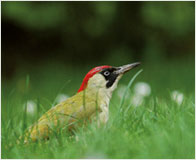
green woodpecker
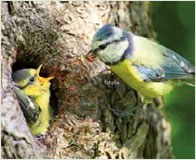
blue tit
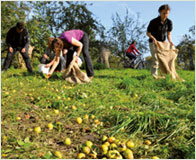
Diurnal and nocturnal hunters
Little owls are typical meadow orchard birds. They nest in holes in trees and hunt mice and large insects, both in daytime and during the night. Finding prey is easier for them if the grass beneath the trees is kept short by grazing.
At dusk the pipistrelle bats leave their hiding places to catch flying insects among the treetops. The loud, laughing call of the Green woodpecker is only heard in the daytime. This bird spends most of the time feeding on the ground, spearing ants with its long tongue.
Seasonal gatherers
When the fruit trees blossom in May, the air in the meadow orchards is filled with the hum of bees and bumblebees. Gathering pollen and nectar, they pollinate the trees and so enable them to produce fruit. During the summer, nesting birds – from blue tit to treecreeper – scour the branches and tree trunks for caterpillars to feed their young. At harvest time you can be a gatherer, too – just join in the fruit-picking events organized by the Haus Bürgel Eco Centre. Any leftover fruit will make an autumnal feast for snails, slugs, mice, and hedgehogs. Even in winter the bare trees provide food, at least for the Great spotted woodpecker, which taps the bark with its beak to extract insects.
Wetland willows
The knobbly pollard willows tell us about former times when farmers used willow branches for shovel handles, bean poles, or fuel. Cropping the upper branches of willows promotes a dense head of fresh growth and helps maintain a sure supply of wood.
Little owls are typical meadow orchard birds. They nest in holes in trees and hunt mice and large insects, both in daytime and during the night. Finding prey is easier for them if the grass beneath the trees is kept short by grazing.
At dusk the pipistrelle bats leave their hiding places to catch flying insects among the treetops. The loud, laughing call of the Green woodpecker is only heard in the daytime. This bird spends most of the time feeding on the ground, spearing ants with its long tongue.
Seasonal gatherers
When the fruit trees blossom in May, the air in the meadow orchards is filled with the hum of bees and bumblebees. Gathering pollen and nectar, they pollinate the trees and so enable them to produce fruit. During the summer, nesting birds – from blue tit to treecreeper – scour the branches and tree trunks for caterpillars to feed their young. At harvest time you can be a gatherer, too – just join in the fruit-picking events organized by the Haus Bürgel Eco Centre. Any leftover fruit will make an autumnal feast for snails, slugs, mice, and hedgehogs. Even in winter the bare trees provide food, at least for the Great spotted woodpecker, which taps the bark with its beak to extract insects.
Wetland willows
The knobbly pollard willows tell us about former times when farmers used willow branches for shovel handles, bean poles, or fuel. Cropping the upper branches of willows promotes a dense head of fresh growth and helps maintain a sure supply of wood.
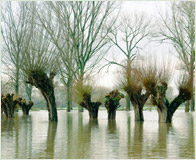
pollard willow -
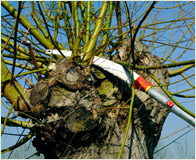
useful plant of the
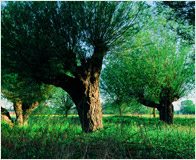
floodplains and wetlands
Close crop
Neglected pollard willows grow top-heavy and the trunks can split. That is why every five to ten years the local hunters and gamekeepers get together with volunteers to give the handsome trees in the nature reserve a good "haircut".
Within the hollow crown
Willows have soft wood that tends to become rotten or brittle at the tree's knobbly joint. This is an ideal home for the larvae of beetles, butterflies, and wild bees. Cavities in the tree trunks are inhabited by Little owls and bats. Even a willow that is completely hollow is still very much alive!
Neglected pollard willows grow top-heavy and the trunks can split. That is why every five to ten years the local hunters and gamekeepers get together with volunteers to give the handsome trees in the nature reserve a good "haircut".
Within the hollow crown
Willows have soft wood that tends to become rotten or brittle at the tree's knobbly joint. This is an ideal home for the larvae of beetles, butterflies, and wild bees. Cavities in the tree trunks are inhabited by Little owls and bats. Even a willow that is completely hollow is still very much alive!
Search:






